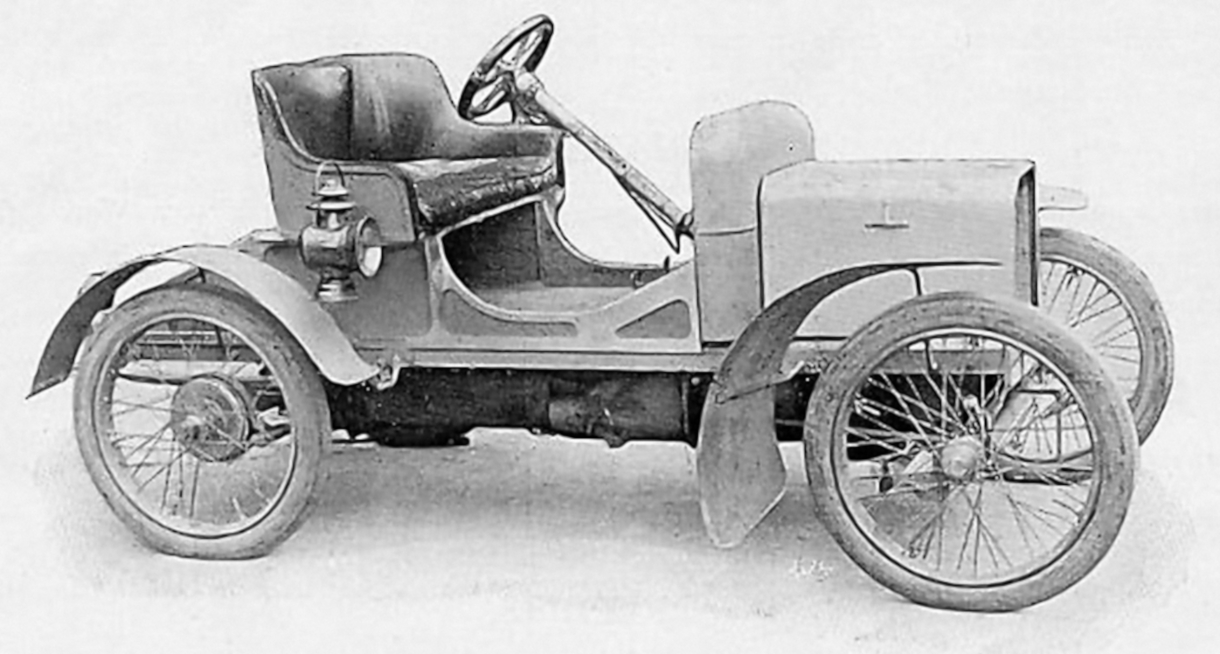
ROVER 8hp 'Eight'
The legendary first ROVER car
1904 - 1912
The image shows the open ROVER 8hp Two-Seater as shown in the first brochure from 1904.
The 8hp, ROVER's first creation in the automotive sector, is a truly exciting car. It is already full of technology and, unlike all important competitor models, is not a replica of a foreign make. That means something in those days.
Designed by Lewis, large parts of the underbody are made of aluminium castings. A complex technology that requires a great deal of knowledge. The central tube frame and the integration of the three-speed gearbox as part of the chassis frame are also state-of-the-art by today's standards.
The vehicle was certainly not particularly comfortable. The rear suspension (longitudinal leaf springs) existed between the rear frame end with the axle unit on the one hand and the body on the other. The unsprung masses must have been enormous. A transversal leaf spring acted in the front.
The engine brake used appears to be advanced. By pressing a pedal the cams are shifted; thus the engine is transformed into an air compressor, which achieves a high braking effect.
For maintenance, the trolley must be dismantled into two parts. The entire body can be folded up for this purpose.
Over the years, both the technology and the body have changed. In 1908 the transmission was shifted to the right, there were high doors and wheel arches. An elegant open body appeared in 1910, characterised by two comfortable, rounded seats and a windscreen fastened with leather straps. The top speed is 38 km/h.
In 1905, one year after its market launch, ROVER offers three body styles from the factory: a two-seater, a three-seater and a four-seater. The ⇒ pictures explain the differences.
The following prices are known:
- 1905 cost
- the chassis £120
- the open two-seater £200
- the open three-seater £220
- the two-seat export model for colonies - with reinforced chassis and larger ground clearance - £225.
- 1907 costs
- the open two-seater £210
- 1912 are due
- for the model without windscreen and without hood £250
- for the open two-seater £265.
As strong as the aluminium chassis may look, the mechanical stresses caused by the rigid axles led to considerable susceptibility to breakage. Lewis is forced to look for other solutions. For these reasons, too, the 6 hp is soon produced, but the 8 hp remains in production.
Even before the official market launch, the ROVER 8hp was compared with the vehicles of the competition in so-called "trials". The following information is given in the first prospectus 1904:
- Bexhill Meeting 1904 - The 8hp single cylinder Rover beats all English and continental cars of its class.
- Sunrising Hill Competition 1904 - The 8hp single cylinder Rover drove faster than all other cars in its performance or price class.
- Blackpool Meeting 1904 Competition on the standing mile - The 8hp single cylinder rover drove faster than twenty other stronger cars between 10 hp and 20 hp.
| Sources | |
|---|---|
 |
1904 The Rover Car - Edition No. 1 Sole Manufacturer: The Rover Cycle Co., Ltd., Meteor Works, Coventry |
 |
1905 Rover Cars - Second Edition Sole Manufacturer: The Rover Cycle Co., Ltd., Meteor Works, Coventry Also includes the Rover 6hp |
 |
1907 Rover Cars - Aut Optimum Aut Nihil - The Best or Nothing. The Rover Co., Ltd., Meteor Works, Coventry Also includes the Rover 6hp and 16-20hp |
 |
1910 Rover Brochure 6hp - 8hp- 12hp - 15hp - 20hp |
 |
Rover Enthusiast Magazine (James Taylor) März 2007 |
1907 visits the
"Motor-Car Journal"
the ROVER plant in Coventry.
Such insights into early production are rare, so we have included the report.
Here you find
⇒ the report.
© 2021-2026 by ROVER - Passion / Michael-Peter Börsig

 Deutsch
Deutsch